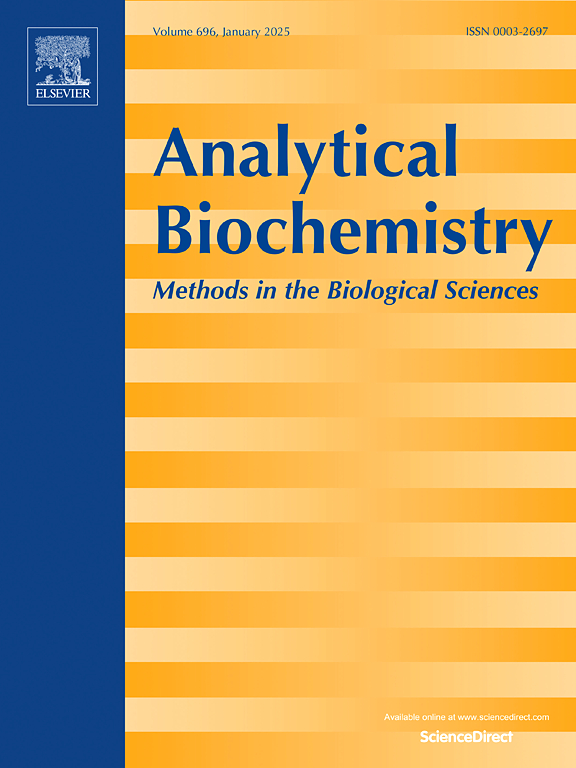基于邻近滚动圆扩增的点亮适体的产生,用于敏感和无标记的MicroRNA分析
IF 2.5
4区 生物学
Q2 BIOCHEMICAL RESEARCH METHODS
引用次数: 0
摘要
microRNA (miRNA)表达异常与肺炎密切相关。然而,由于其序列短且在生物样品中的丰度低,超灵敏的miRNA检测在技术上仍然具有挑战性。在此,我们开发了一种催化发夹组装触发的接近滚环转录系统,用于合成孔雀石绿(MG)结合RNA适配体,实现无标记和高灵敏度的miRNA-21检测。在该系统中,靶miRNA-21启动发夹探针结构重排,促进miRNA-21再循环,激活双滚环转录反应。由此产生的长RNA转录本经过部分杂交,产生许多功能的MG RNA适配体。在与MG染料结合后,这些适体产生强大的荧光信号,允许在低至0.51 fM的浓度下检测超灵敏的miRNA-21。该方法具有高特异性,能够从单碱基错配序列中区分miRNA-21,并有望监测临床样品中miRNA-21的表达。该方法将滚动环转录的信号放大与MG适配体的高亲和力识别相结合,具有低背景、优越的信噪比和卓越的灵敏度。此外,该策略可以很容易地通过修改目标识别序列来检测其他痕量生物标志物。本文章由计算机程序翻译,如有差异,请以英文原文为准。

Proximity rolling circle amplification based generation of lighting-up aptamer for sensitive and label-free MicroRNA analysis
The dysregulated expression of microRNA (miRNA) has been strongly linked to pneumonia. However, ultrasensitive miRNA detection remains technically challenging due to their short sequences and low abundance in biological samples. Herein, we developed a catalytic hairpin assembly -triggered proximity rolling circle transcription system for synthesizing malachite green (MG)-binding RNA aptamers, enabling label-free and highly sensitive detection of miRNA-21. In this system, target miRNA-21 initiates hairpin probe structural rearrangement, promoting miRNA-21 recycling and activating dual rolling circle transcription reactions. The resulting long RNA transcripts undergo partial hybridization, yielding numerous functional MG RNA aptamers. Upon binding to MG dye, these aptamers generate a robust fluorescence signal, allowing ultrasensitive miRNA-21 detection at concentrations as low as 0.51 fM. The assay exhibits high specificity, discriminating miRNA-21 from single-base mismatched sequences, and shows promise for monitoring miRNA-21 expression in clinical samples. By combining the signal amplification of rolling circle transcription with the high-affinity recognition of MG aptamers, this method achieves a low background, superior signal-to-noise ratio, and exceptional sensitivity. Furthermore, the strategy can be readily adapted to detect other trace biomarkers by modifying the target-recognition sequence.
求助全文
通过发布文献求助,成功后即可免费获取论文全文。
去求助
来源期刊

Analytical biochemistry
生物-分析化学
CiteScore
5.70
自引率
0.00%
发文量
283
审稿时长
44 days
期刊介绍:
The journal''s title Analytical Biochemistry: Methods in the Biological Sciences declares its broad scope: methods for the basic biological sciences that include biochemistry, molecular genetics, cell biology, proteomics, immunology, bioinformatics and wherever the frontiers of research take the field.
The emphasis is on methods from the strictly analytical to the more preparative that would include novel approaches to protein purification as well as improvements in cell and organ culture. The actual techniques are equally inclusive ranging from aptamers to zymology.
The journal has been particularly active in:
-Analytical techniques for biological molecules-
Aptamer selection and utilization-
Biosensors-
Chromatography-
Cloning, sequencing and mutagenesis-
Electrochemical methods-
Electrophoresis-
Enzyme characterization methods-
Immunological approaches-
Mass spectrometry of proteins and nucleic acids-
Metabolomics-
Nano level techniques-
Optical spectroscopy in all its forms.
The journal is reluctant to include most drug and strictly clinical studies as there are more suitable publication platforms for these types of papers.
 求助内容:
求助内容: 应助结果提醒方式:
应助结果提醒方式:


